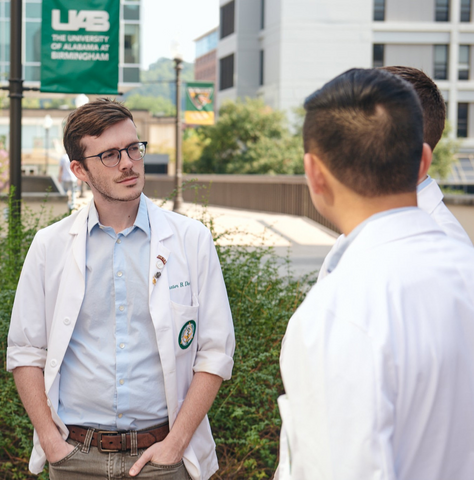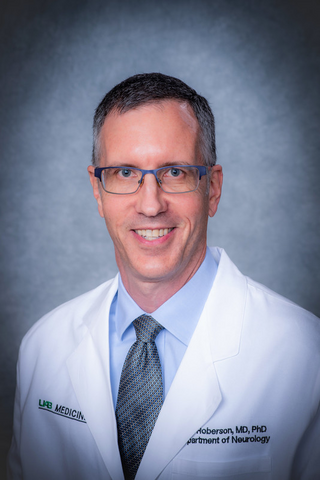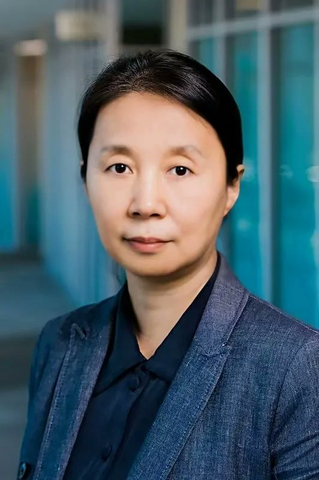Media contact: Jeff Hansen
 Hunter Dean, Ph.D.In the summer of 2018, graduate student Hunter Dean from the Medical Scientist Training Program came to Yuhua Song, Ph.D., with a research idea. He wanted to pursue his doctoral research at the University of Alabama at Birmingham in Alzheimer’s disease — under the joint mentorship of Song, who had never worked in Alzheimer’s, and Erik Roberson, M.D., Ph.D., an Alzheimer’s expert in the UAB Department of Neurology and the Center for Neurodegeneration and Experimental Therapeutics, or CNET.
Hunter Dean, Ph.D.In the summer of 2018, graduate student Hunter Dean from the Medical Scientist Training Program came to Yuhua Song, Ph.D., with a research idea. He wanted to pursue his doctoral research at the University of Alabama at Birmingham in Alzheimer’s disease — under the joint mentorship of Song, who had never worked in Alzheimer’s, and Erik Roberson, M.D., Ph.D., an Alzheimer’s expert in the UAB Department of Neurology and the Center for Neurodegeneration and Experimental Therapeutics, or CNET.
That collaboration brought Song, a professor in the UAB Department of Biomedical Engineering, into research on this leading cause of dementia worldwide. In addition, the collaboration has now garnered $5.68 million of grant support — proceeding from a $660,000 award from the Alzheimer’s Drug Discovery Foundation in 2019 with Roberson as principal investigator and Song as co-investigator to two awards with Song as PI and Roberson as co-investigator — a five-year $2.13 million National Institutes of Health R01 grant in 2021 and a five-year $2.89 million NIH R01 grant this summer.
The strength that Song brought into this unusual collaboration is computational biology — using supercomputers to model a key Alzheimer’s protein called TREM2 and its interactions with small chemical molecules. These molecules include both ligands produced in the body and existing drugs that are prescribed for other diseases but may also prove useful to treat Alzheimer’s. Integrated computational modeling on UAB’s Cheaha Supercomputer can identify drugs that should bind to TREM2 — first searching from a database of more than 80,000 human metabolites and then from a library of more than 6,000 drugs, including preclinical drugs, clinical trial drugs, and existing U.S. Food and Drug Administration-approved drugs. Hits identified by the unbiased virtual screening can then be validated with biophysical and biological experiments.
 Erik Roberson, M.D., Ph.D.Why is TREM2 important? Genome-wide association studies have found that single amino acid variants in TREM2 are one of the strongest genetic risk factors for late-onset Alzheimer’s disease. This means TREM2 could hold a key to progress in finding a drug to treat the disease.
Erik Roberson, M.D., Ph.D.Why is TREM2 important? Genome-wide association studies have found that single amino acid variants in TREM2 are one of the strongest genetic risk factors for late-onset Alzheimer’s disease. This means TREM2 could hold a key to progress in finding a drug to treat the disease.
TREM2 is a transmembrane receptor protein found on microglial cells, the resident macrophages in the central nervous system. In these brain immune cells, TREM2 can act to stimulate phagocytosis by the microglia to remove damaged cells, or TREM2 can act to suppress inflammation.
“New knowledge gained from this study could have a major impact for Alzheimer’s disease research and treatment,” Song said. “By repositioning available drugs, we can search for new drug combinations to target TREM2 for Alzheimer’s disease treatment.”
In previous studies, Song’s team identified two ligand-binding sites in TREM2, including a basic site that contains most of the Alzheimer’s disease-associated residues on TREM2, and a hydrophobic site that resembles the complementarity-determining regions that give antibodies their specificity. The hypothesis in Song’s research is that available drugs, including FDA-approved drugs, could bind TREM2 at either its basic and/or hydrophobic binding sites.
 Yuhua Song, Ph.D. Binding of a molecule to a protein can have an allosteric effect — a change in the protein’s conformation that can either boost or diminish its activity. This allosteric effect caused by drug(s) binding at either site could drive TREM2-mediated immune activities as a treatment for Alzheimer’s disease, even in the presence of TREM2 variants that are associated with increased risk of late-onset Alzheimer’s. These potential drugs will then be validated in macrophages and microglia, looking for the drugs that best activate phagocytosis and cytoprotection.
Yuhua Song, Ph.D. Binding of a molecule to a protein can have an allosteric effect — a change in the protein’s conformation that can either boost or diminish its activity. This allosteric effect caused by drug(s) binding at either site could drive TREM2-mediated immune activities as a treatment for Alzheimer’s disease, even in the presence of TREM2 variants that are associated with increased risk of late-onset Alzheimer’s. These potential drugs will then be validated in macrophages and microglia, looking for the drugs that best activate phagocytosis and cytoprotection.
Dean, a student in UAB’s Medical Scientist Training Program and the instigator of Song and Roberson’s synergistic TREM2 research, is now known as Hunter Dean, Ph.D. He has moved on to finishing his M.D. studies after successfully defending his dissertation this summer. Song says both Dean and Ph.D. graduate student Rory Greer have been invaluable contributors in the TREM2 research.
Collaborating with Song and Roberson on her 2023 NIH R01 grant is Thomas Brett, Ph.D., Washington University, St. Louis, Missouri.
At UAB, Biomedical Engineering is a joint department in the Marnix E. Heersink School of Medicine and the School of Engineering, and Neurology is a department in the Heersink School of Medicine. Roberson holds the Rebecca Gale Endowed Professorship for Alzheimer’s Disease and is the director of CNET and the NIH-funded Alzheimer’s Disease Center at UAB.
